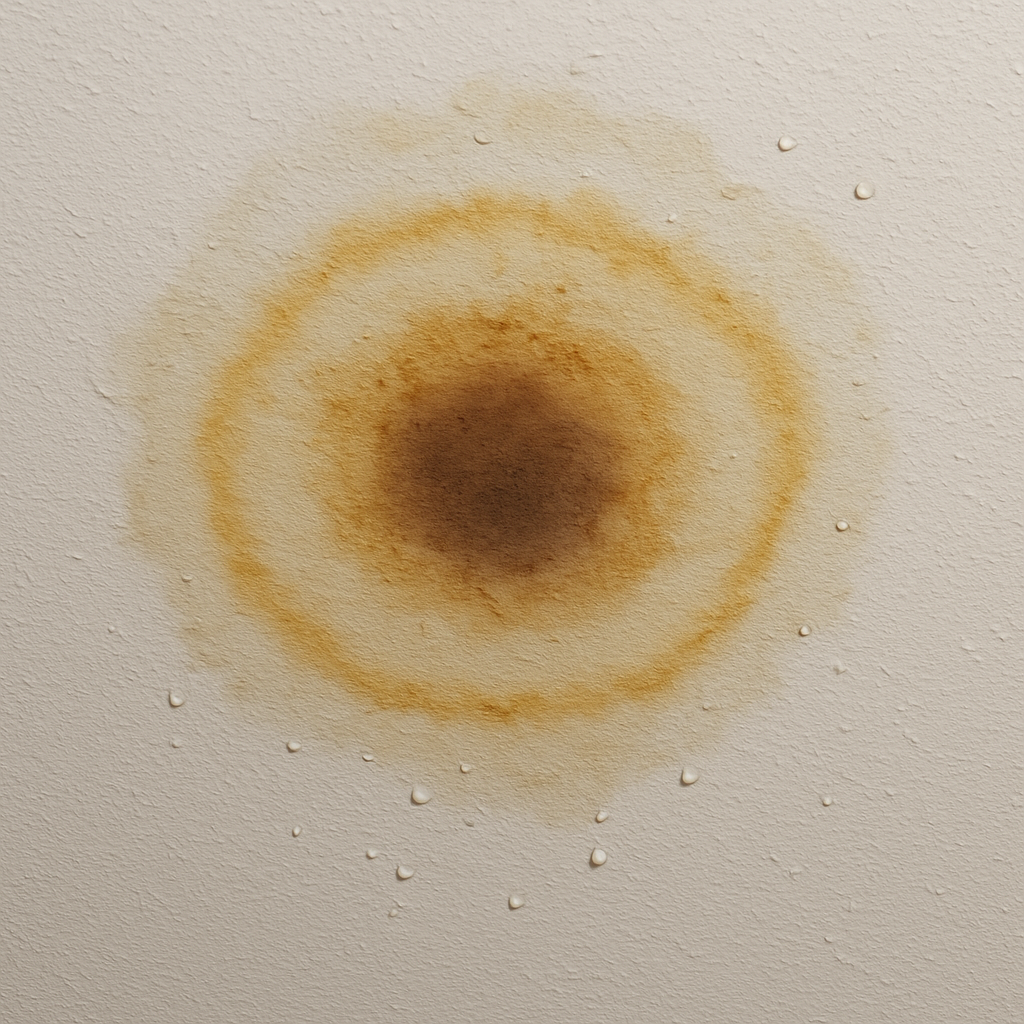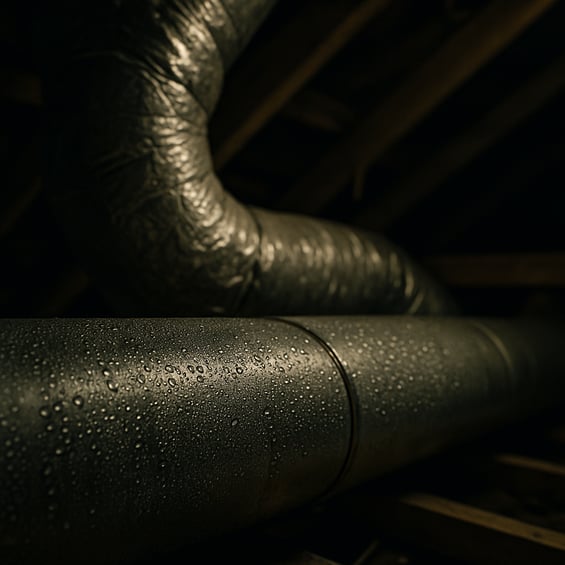What Does a Water Spot on My Ceiling Mean? (And What to Do About It)

Have you noticed a water stain on your ceiling? Not sure where to start—or even who to call—when it comes to figuring out the source? Ceiling spots can be tricky because they don't always point to the same problem.
Sometimes the source is a roof leak, other times it's from a plumbing issue. What matters most is acting quickly, because waiting too long can turn a small stain into major damage or costly repairs.
At Happy Roofing, we've helped countless homeowners identify and fix the cause of mysterious water stains. Sometimes, the source can travel from somewhere else entirely, making it even more stressful and confusing to figure out on your own.
In this article, we'll break down the most common reasons water spots appear on ceilings, the first steps you should take if you notice one in your home, and how to find the source of the leak. By the end, you'll have a clear understanding of how water spots on the ceiling form, who to call if you're experiencing one, and how to prevent relatively minor leaks from becoming major problems.
Table of Contents
- What Do Ceiling Water Stains Mean?
- The Most Common Causes of Ceiling Water Stains
- How to Tell if Your Ceiling Stain Is From a Roofing, Plumbing, or HVAC issue
- What to Do if You Notice a Water Stain on Your Ceiling
- Common Roof Leak Repairs
- Protect Your Home Without Risking Your Safety
What Does a Water Stain on My Ceiling Mean?
A water stain on your ceiling is often the first visible clue of a bigger moisture problem behind the surface. The challenge for homeowners is that these stains don't always reveal exactly where that leak is coming from.
Sometimes, these leaks can trace back to a roof leak. Other times, plumbing issues or even excessive condensation can be the cause. To add to the confusion, water often travels before it shows up as a stain inside your home, so the spot you see may be several feet away from the problem area.
Ignoring ceiling stains can be costly. Even a small leak can cause wood to rot, weaken structural components, and create the perfect environment for mold growth. What appears as a faint yellow ring can be a warning of widespread damage inside walls, insulation, or attic spaces.

What are the Common Causes of Water Spots on the Ceiling?
Water spots on the ceiling are usually caused by roof leaks, poor attic ventilation, plumbing issues, or problems with your HVAC system. Each potential problem has different warning signs and risks, but all of them point to unwanted water getting into your home.
Below, we'll break down the most common causes so you can better understand where the issue might be coming from.
How Do Roof Leaks Lead to Ceiling Water Spots?
Roof leaks can cause ceiling water spots when moisture makes its way through damaged shingles, flashing, or underlayment and eventually seeps into the home. This is one of the most common reasons water stains show up inside.
Some roof-related issues that cause interior leaks include:
- Loose or damaged shingles: Over time, shingles can lift, crack, or lose their protective layer (granules), especially after repeated exposure to strong winds or hail. This makes them more vulnerable to water penetration. Once moisture gets in, it doesn't always drip straight down, and it can follow the slope of the roof or wood framing before appearing indoors as a stain.
- Nail pops: Roofing nails can work their way out of shingles due to temperature changes, wood expansion, or improper installation. Even a slightly raised nail creates a tiny entry point for water, which can slowly seep in over time and lead to interior staining.
- Compromised flashing: Flashing is the thin metal installed around chimneys, skylights, vents, and roof-to-wall transitions to seal vulnerable joints. When the caulking dries out, screws loosen, or flashing starts to wear and separate, it creates an easy entry point for water. Leaks from flashing are especially misleading because water often travels along the metal before dripping somewhere else entirely inside the house.
- Failing or poorly installed underlayment: Underlayment is the waterproof barrier beneath your shingles that protects against moisture if any water gets through the shingles. If it's installed incorrectly, worn from age or weather exposure, or torn, it won't do its job effectively. That means even minor roof surface problems can quickly become major leaks inside your home.
Below is an example of a nail pop:

How Poor Attic Ventilation Can Cause Water Spots on the Ceiling
Not all ceiling stains come from outside leaks. Sometimes the problem starts inside your home. When an attic isn't properly ventilated, warm, moist air from daily activities (like cooking, showering, or laundry) rises and gets trapped.
This moisture condenses on the underside of the roof decking, almost like water droplets forming on a cold glass. If this moisture builds up enough, water can drip onto insulation and your ceiling from above, causing water marks.
Signs of poor attic ventilation include:
- Widespread stains: Unlike the sharp yellow-brown rings caused by an isolated roof leak, condensation spots are often smaller and spread out across larger areas. The surrounding location can also be damp or warped, indicating widespread moisture rather than a localized drip.
- Warped wood or roof decking: Continuous moisture exposure causes the plywood or Oriented Strand Board (OSB) sheets of decking under your shingles to weaken, warp, or rot, which compromises the structural integrity of your roof. This isn't always visible from inside the attic (often requiring shingle removal to verify), but if you do notice signs of wood rot or warping, it's indicative of poor ventilation.
- Mold growth in the attic: A damp attic creates the perfect environment for mold. This can develop on the decking, spread to insulation, and even affect indoor air quality throughout the home. Signs of moisture (like rusted roofing nails) or mold growth signify a ventilation issue.
Here is an example of how poor ventilation caused excessive mold growth in this attic, spreading across the roof decking:

Can Plumbing Leaks Cause Water Spots on the Ceiling?
Even on a top-floor ceiling, where it's natural to assume the roof is to blame, leaks from pipes or other plumbing connections above can create nearly identical stains.
Ceiling stains don't always point to a roofing problem, especially if the spot shows up on a lower-floor ceiling (away from the roof), where plumbing lines between floors are often the culprit.
Common ways plumbing can cause ceiling stains include:
- Leaky pipe joints or fittings: Over time, seals can fail or connections loosen, allowing water to seep out slowly and leave behind faint, ringed stains that darken over time.
- Burst or cracked pipes: In colder climates, pipes that freeze and expand may rupture, leading to sudden, severe water damage in ceilings and walls. If the leak appears and is growing rapidly with no rainstorm in sight, it may be due to a burst pipe.
- Fixture-related leaks: Showers, tubs, and sinks located above a ceiling can create stains if their drains or supply lines develop even a small leak. In these cases, spots often worsen right after the fixture is used.
It's not always easy to rule out plumbing leaks, but they can escalate quickly and can often create a sudden stain or worsening damage in a matter of hours or days. Taking photos when you notice the stain can show you how quickly it's spreading.
If a stain appears or grows after heavy rain and forms near the edges of your ceiling, it likely points to a roof leak. If the spot shows up directly beneath a bathroom or plumbing fixture, and doesn't seem affected by rain, chances are it's coming from a pipe issue instead.
Can HVAC Issues Cause Water Spots on the Ceiling?
While not as common as other issues, HVAC problems can sometimes lead to ceiling stains, especially if you have ducts or air handlers running through the attic.
Condensation buildup, clogged drain lines, or poorly insulated ducts can allow water to drip onto the ceiling below.
Some common HVAC-related causes include:
- Clogged AC drain lines: When condensation lines get blocked, water backs up with nowhere to drain and can overflow. This buildup of water can lead to water spots.
- Leaking drip pans: Sometimes, a home's air handler unit is located in the attic. A cracked or rusted drip pan (meant to catch water from drains or backups) under your air handler can let water escape and pool in the attic space, leading to water stains visible from below.
- Poorly insulated ducts: In hot, humid weather, uninsulated ducts can "sweat," creating enough moisture to leave dark marks on ceilings once they begin to drip.
Below is an example of what condensation buildup on an HVAC duct could look like:

How to Tell if a Ceiling Stain Is from a Roof Leak, Pipe Leak, or HVAC Issue
| Identifying Factors | Roof Leak | Plumbing Leak | HVAC Issue |
|---|---|---|---|
| Ceiling Stains | Consistent appearance with brown or yellow rings | Irregular stains that may grow quickly and can appear darker | Typically start small or faint, but can gradually spread |
| Timing of Leak | Leak appears/spreads during or following rainstorms | Can appear suddenly, and unrelated to the weather | Often shows up or grows when the AC is running |
| Location | Near exterior walls, roof valleys, or ceiling edges | Directly under bathrooms, kitchens, or other heavily plumbed areas | Typically near vents, ducts, or directly under attic HVAC units |
| Attic Inspection | Damp insulation, discolored roof decking, isolated mold growth | Attic above is dry; no visible roof damage | Pooling near HVAC unit, wet insulation under ducts, or rusted drip pans |
| Additional Signs | Missing shingles or other visible damage on the roof near the leak location | Moisture, condensation, or leaks at pipe joints and fittings | Blocked AC drain line, or "sweating" ducts dripping moisture |
What Do I Do If I Notice a Water Spot on My Ceiling?
The moment you notice a water stain on your ceiling, quick action like documenting the size and location, and calling a contractor can make the difference between a minor repair and hundreds or even thousands of dollars in damage.
Here are the first steps every homeowner should take if they notice a water spot on their ceiling:
- Document the damage: Take clear photos of the stain from different angles. If the leak is active, snap pictures of the water entry point (if possible) and any belongings affected. This documentation is helpful both for insurance claims and for giving a contractor context before they arrive.
- Check the attic or roof area above the spot (if safe): If you can safely access your attic, look for signs of wet insulation, damp roof decking, or active dripping. This helps confirm whether the issue is roof-related or potentially plumbing/HVAC. If it's unsafe or unclear, skip this step and move straight to the next.
- Contain the leak: If water is actively dripping, place a bucket underneath and use towels or tarps to protect the surrounding flooring and furniture. Puncturing a bulging ceiling bubble with a small hole can also safely relieve pressure and prevent the ceiling from collapsing, but it's not recommended to do this if you can't verify that the water is clean.
- Call a contractor promptly: Don't wait and hope the stain goes away. The sooner a roofing contractor (or plumber/HVAC technician, if it looks plumbing or HVAC-related) can assess the problem, the less likely it is to spread and cause hidden structural or mold damage.
What Repairs Might Be Needed to Fix a Roof Leak?
When it comes to fixing roof leaks, the right repair depends entirely on the cause. Some leaks can be managed with relatively small, isolated repairs, while others require extensive replacement of supporting components like roof decking.
Since we specialize in roofing and ventilation solutions, we can't speak much on fixes for plumbing or HVAC issues, but we can outline the most common roofing-related repairs you might face if a leak or ventilation problem is to blame for your ceiling water spot:
- Quick Fixes – If the problem is localized, repairs might be as simple as:
- Replacing missing or damaged shingles to stop water intrusion.
- Patching minor roof penetrations or exposed nail heads to restore waterproofing.
- Resealing flashing where caulking has worn out and allowed water to seep through.
- More Extensive Repairs – Sometimes the damage extends beyond the surface:
- Replacing the compromised underlayment when water has gotten past the shingles.
- Repairing or replacing sections of roof decking that have warped, rotted, developed mold, or need ventilation updates.
- Replacing flashing around chimneys, vents, or roof-to-wall transitions where the existing material has worn out (to do this properly, shingles and siding have to be lifted and replaced as well).
- Interior Damage Repairs – Roof leaks can cause interior damage, especially in cases where they’ve been active for some time:
- Drywall repair or replacement may be needed if ceiling materials become stained or soft.
- Wet insulation often has to be removed and replaced to restore energy efficiency and prevent mold.
- Mold remediation may be required if moisture has lingered, especially in attics or poorly ventilated areas.
Some water stains can be resolved with quick, targeted fixes, but others signal deeper issues that require more significant repairs. Acting quickly not only protects your roof, but it also saves you from escalating costs inside your home.
Protect Your Home Without Risking Your Safety
Ceiling water spots can signal larger underlying issues, whether they're roof, plumbing, or HVAC related. While some roof leak fixes are straightforward, others require more in-depth repairs. In either case, trying to handle them yourself can put both your roof and your safety at risk.
That's why it's important to know what you can look out for as a homeowner and when it's time to call in the experts. Staying on top of any signs that your roof may have a problem can save you from future headaches and costly repairs.
If you'd like to go more in-depth on other roofing issues to be on the lookout for as a homeowner, be sure to read our next article: What Are the Most Common Roofing Problems Homeowners Should Watch For—And How Are They Fixed? It covers other common roofing problems, why they happen, and the safe next steps to take if you spot them on your home.
If you're experiencing a leak and suspect it's coming from your roof, scheduling a professional assessment can give you clear answers about the source of the leak and the overall health of your roof.
The Author: Pedro Toledano
Happy Roofing is a trusted roofing company dedicated to providing top-quality roofing services to residential and commercial clients. With years of experience, they specialize in roof installations, repairs, and maintenance, ensuring durability and customer satisfaction. The team is known for their professional approach, timely service, and attention to detail. Happy Roofing prides itself on using high-quality materials and offering competitive pricing. Follow their Facebook page for updates on projects, customer testimonials, and tips on maintaining your roof in excellent condition.





